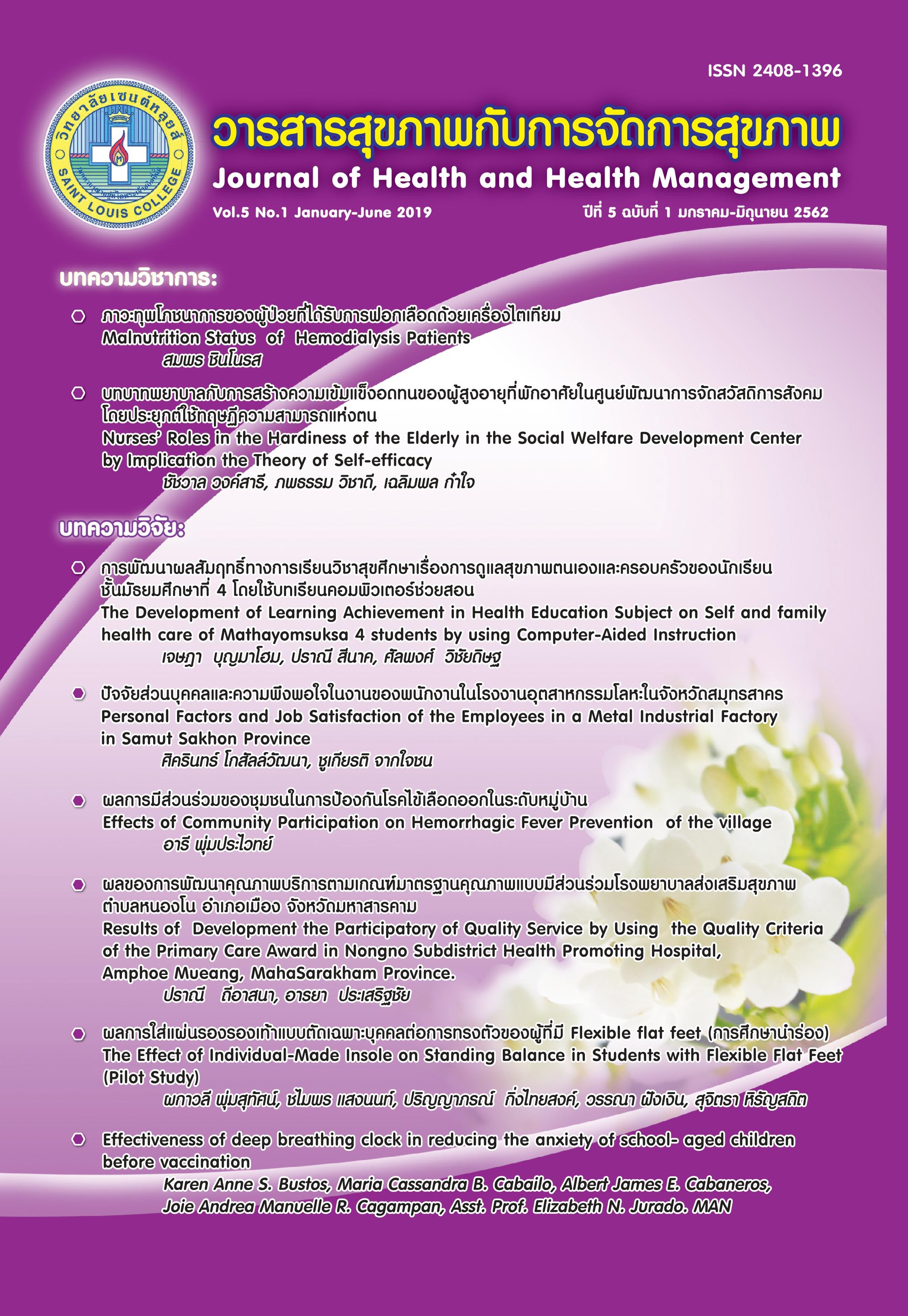The Effect of Individual-Made Insole on Standing Balance in Students with Flexible Flat Feet (Pilot Study)
Keywords:
Insole, Flexible flat feet, BESSAbstract
Flat feet are the condition which Medial Longitudinal Arch (MLA) of feet collapses. The prevalence of flat feet in healthy adult aged 18-21 years is 13.6%. Flat feet results more weight bearing in medial side of feet during standing, walking, or running which influences on activity daily living. The objective of this study was to study the effect of insole on balance of volunteer with flexible flat feet. The samples were fifteen volunteers aged 18-25 years (21+1.2 years) with flexible flat feet, BMI ≤ 22.9 kg/m2, BESS score > 5 were recruited. The simple sampling was used to divide insole group and no insole group. 8 volunteers in insole group had insole shoes for 3 weeks. 7 volunteers in no insole group had no insole shoes. BESS score was measured at beginning of 1st week and the end of 3rd week in both group. Data analysis pre average BESS and 3rd average BESS in each group were analyzed by Dependent t-test. Pre average BESS and 3rd average BESS between groups were analyzed by Independent t-test at p-value ≤0.05. The results indicated that the comparison of 3rd average BESS score between insole group (5.25±1.04) and no-insole group (7.14±1.07) showed significance differences (P≤0.05). Conclusion: Volunteers with individual invented insole shoes for 3 weeks had average BESS significant better than volunteers with no-insole shoes (P≤0.05).
References
Aenumulapalli, A., Kulkarni, M.M., & Gandotra, A.R. (2017). Prevalence of flexible flat feet in adults: A cross-sectional study. J Clin Diagn Res, 11(6), AC17- AC20.
Bhoir, T., Anap, D.B., & Diwate, A. (2014). Prevalence of flat foot among 18 -25 years old physiotherapy students: cross sectional study. IJBAMR, 3 (4), 272-278.
Bloch, R. (2007). Geriatric rehabilitation. Physical medicine and rehabilitation. Philadelphia: Elsevier, 1415-31.
Iverson, G.L., & Koehle, M.S. (2013). Normative data for the balance error scoring system in adults. Rehabilitation Research and Practice, 2013,http://dx.doi.org/10.doi: 10.1155/2013/846418, 1-5.
Kido, M., Ikoma, K., Hara, Y., Imai, K., Maki, M., Ikeda, T., …. Kubo, T. (2014). Effect of therapeutic insoles on the medial longitudinal arch in patients with flatfoot deformity: a three-dimensional loading computed tomography study. Clin Biomech, 29(10), 1095-1098.
Lee, H.J., Lim, K.B., Yoo, J.H., Yoo, S.W., Yun, H.J., & Jeong, T.H. (2015). Effect of custommolded foot orthoses on foot pain and balance in children with symptomatic flexible flat feet. Ann Rehabil Med, 39(6), 905-913.
Mosca, V.S. (2010). Flexible flatfoot in children and adolescents. Child Orthop, 4, 107–121.
Oleksy, L., Mika, A., Gornay, A.L., & Marchewka, A. (2010). Intrarater reliability of the Foot Posture Index (FPI-6) applied as a tool in foot assessment in children and adolescents. Medical Rehabilitation, 14 (4), 10–20.
Redmond, A.C., Crane, Y.Z., & Menz, H.B. (2008). Normative values for the Foot Posture Index. J Foot Ankle Res, 1:6, doi: 10.1186/1757-1146-1-6, 1-9.
Sachithanandam, V., & Joseph, B. (1995). The influence of footwear on the prevalence of flat foot. A survey of 1846 skeletally mature persons. J Bone Joint Surg, 77-B (2), 254- 257.
Takata, Y., Matsuoka, S., Okumura, N., Iwamoto, K., Takahashi, M., & Uchiyama, E. (2013). Standing balance on the ground-The influence of flatfeet and insoles. J Phy Ther Sci, 25(12), 1519-1521.
Telegbal, V.S. (2015). Static Foot Posture - Predictor of Dynamic Foot Motion. J Nov Physiother, 5: 272. doi:10.4172/2165-7025.1000272, 1-4.
Tucker, M.R., Olivier, J., Pagel, A., Bleuler, H., Bouri, M., Lambercy O, Gassert R. (2015). Control strategies for active lower extremity prosthetics and orthotics: a review. J Neuroeng Rehabil, 12:1. doi: 10.1186 /1743-0003-12-1, 1-29.




